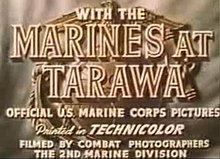With the Marines at Tarawa
| With the Marines at Tarawa | |
|---|---|
 Title screen | |
| Directed by | Louis Hayward (uncredited) |
| Cinematography | Norman T. Hatch |
Production company | |
| Distributed by | Universal Pictures |
Release date |
|
Running time | 18 minutes |
| Country | United States |
| Language | English |
With the Marines at Tarawa is a 1944 short documentary film directed by Louis Hayward. It uses authentic footage taken at the Battle of Tarawa to tell the story of the American servicemen from the time they get the news that they are to participate in the invasion to the final taking of the island and raising of the Stars and Stripes.
Synopsis
[edit]Most of the film is in full color and it uses no actors, making it a valuable historical document. The documentary showed more gruesome scenes of battle than other war films to date. Marine Staff Sergeant Norman Hatch, armed with a .45 caliber pistol and a Bell & Howell hand-cranked Eyemo camera, captured 35mm film footage as near as 15 yards away from the enemy during combat.[1] According to the documentary The War, President Franklin D. Roosevelt himself gave approval for showing the film, against the wishes of many advisors.
Since the pictures were far too graphic to meet the standards of Hollywood producers and distributors, only the President could grant permission for its release to the general public. President Roosevelt consulted the only man who was present at the Battle of Tarawa that he personally knew and trusted, Time-Life photographer Robert Sherrod. Quoting Sherrod, "I tell the President the truth. Our soldiers on the front want people back home to know that they don't knock the hell out of them every day of every battle. They want people to understand that war is a horrible, nasty business, and to say otherwise is to do a disservice to those who died." Based on Sherrod's prompting, FDR agreed to release the film, uncensored.[2]
The film won the 1944 Oscar for Best Documentary Short Subject.[3][4] The Oscar was presented to the US Marine Corps, and today a replica Oscar is displayed at the National Museum of the Marine Corps. Due to the shortages of metals needed during the war effort, the Academy presented the Marine Corps with a plaster statue in the shape of a tablet. It is also housed at the same museum, but is not on display.
The Academy Film Archive preserved With the Marines at Tarawa in 2005.[5]
-
The film.
-
Tarawa beach, where the graphic footage of American corpses was filmed.
See also
[edit]References
[edit]- ^ Sam Roberts (newspaper journalist) (2 May 2017). "Norman T. Hatch, Who Filmed Grisly World War II Combat, Dies at 96". The New York Times. p. B14. Retrieved 3 May 2017.
- ^ "History.com: World War II in HD, Episode 3, "Bloody Resolve"". History.com. Archived from the original on 2009-10-28. Retrieved 2009-11-19.
- ^ "NY Times: With the Marines at Tarawa". Movies & TV Dept. The New York Times. Archived from the original on 2012-10-15. Retrieved 2008-11-23.
- ^ "The 17th Academy Awards (1945) Nominees and Winners". oscars.org. 4 October 2014. Retrieved May 29, 2019.
- ^ "Preserved Projects". Academy Film Archive.
External links
[edit]- With the Marines at Tarawa at IMDb
- Norman Hatch interview http://www.theworldatwar.info/normanhatch.html
- The short film With the Marines at Tarawa is available for free viewing and download at the Internet Archive.
- High definition version of the film on YouTube, posted by the National Archives and Records Administration
- The entire film streamed at the National Public Radio website. Part of a story by Tom Bowman, "WWII Combat Cameraman: 'The Public Had To Know'," Mon March 22, 2010, which includes an interview w/ cinematographer Staff Sgt. Norman T. Hatch.
- movie poster
- With the Marines at Tarawa at the National Archives and Records Administration
- 1944 films
- Battle of Tarawa
- Best Documentary Short Subject Academy Award winners
- American short documentary films
- Films about the United States Marine Corps
- American World War II propaganda shorts
- Kiribati in World War II
- 1944 short documentary films
- Universal Pictures short films
- Pacific War films
- 1940s English-language films
- 1940s American films
- English-language short documentary films
- English-language war films

